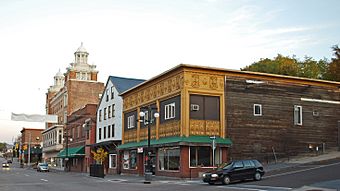Shelden Avenue Historic District facts for kids
Quick facts for kids |
|
|
Shelden Avenue Historic District
|
|

Corner of Sheldon and Huron, looking east
|
|
| Location | Shelden, Lake, & Montezuma Aves., Houghton, Michigan |
|---|---|
| Area | 22.2 acres (9.0 ha) |
| Architect | Ottenheimer, Henry L.; Charlton, Gilbert,& Demar |
| Architectural style | Classical Revival, Renaissance, Romanesque |
| NRHP reference No. | 87002154 |
| Added to NRHP | December 30, 1987 |
The Shelden Avenue Historic District is a special area in Houghton, Michigan, filled with many old and important buildings. It's located along Shelden, Lake, and Montezuma Avenues. This district has 43 buildings that are considered historically important, including two famous ones: the Douglass House and the Shelden-Dee Block. These buildings cover about 22 acres. Because of its historical value, the district was added to the National Register of Historic Places in 1987.
Contents
What Makes the Shelden Avenue Historic District Special?
This historic district is home to the largest collection of beautiful and important commercial buildings in the western Upper Peninsula of Michigan. Most of the buildings here were used for businesses, like shops and offices. But you can also find other types of structures, such as warehouses, meeting halls for clubs, city buildings, a movie theater, and even an old train station.
A Look Back: When Were These Buildings Built?
The buildings in the Shelden Avenue Historic District were constructed over many years, from the 1870s all the way to the 1980s. However, most of them were built between 1880 and 1910. This was a very busy time for the area because of the "copper boom." Many people moved to the Keweenaw Peninsula to work in the copper mines, and new businesses and buildings were needed to support them.
What Do the Buildings Look Like?
The buildings in the district show off many different architectural styles. You can see examples of Late Victorian commercial buildings, which often have lots of decorative details. There are also buildings in the Richardsonian Romanesque style, known for its strong, heavy stone look, and the Renaissance Revival style, which brings back ideas from ancient Roman and Greek architecture. Some buildings even show the Prairie School style, which focuses on horizontal lines and natural materials.
Many of the most impressive buildings were designed by famous architects from bigger cities like Detroit, Chicago, and Marquette. They used local materials for construction, including waste rock from the copper mines and beautiful red sandstone found nearby. The buildings range from one to four stories tall, each telling a part of Houghton's rich history.
Images for kids







